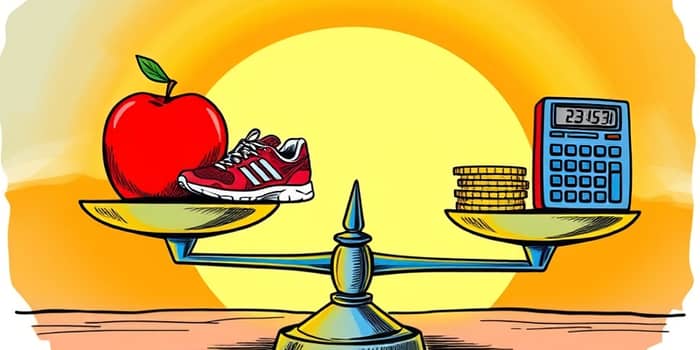In an era where unexpected expenses and sedentary habits pose significant risks, achieving harmony between economic stability and physical vitality has never been more crucial. By recognizing the interplay between your wallet and your well-being, you can build a future that thrives on both fiscal resilience and robust health. This comprehensive guide marries insights from 2025 financial trends with proven wellness strategies to inspire and empower you on this rewarding path.
Current State of Financial Health in 2025
The global financial health score has remained relatively stable at 55 out of 100, signaling that while many individuals are making strides in financial learning and planning, widespread stress persists. Over half of Americans (53%) report feeling overwhelmed by their personal finances, and almost one in three (30%) describes their relationship with money as stressful. This collective strain reflects broader economic pressures, including inflationary trends and uncertain labor markets, which continue to test budgets across income brackets.
Analysis between December 2021 and January 2024 reveals increasing polarization. Respondents are more likely to report lives that are either better than expected or worse than expected—fewer fall in the middle. Lower-income households (below $30,000 annually) have seen a rise in "worse-than-expected" financial quality of life, climbing from 33% to 41%. Interestingly, even higher-income households (earning $100,000 or more) report growing dissatisfaction, underscoring that financial stress is not confined to any single demographic.
Top Financial Concerns and Priorities
Understanding what keeps consumers awake at night is the first step toward actionable solutions. Surveys from 2025 highlight the primary concerns weighing on Americans’ minds, as well as their top financial priorities for the year.
- Unexpected expenses (38%)
- Impact of inflation on daily costs and savings (37%)
- Economic uncertainty or potential recession (32%)
- Ability to pay monthly bills on time (35%)
- Having money left over to save (36%)
- Paying down existing debt (33%)
- Ensuring adequate retirement savings (32%)
Looking beyond immediate worries, Americans are setting their sights on long-term goals. The following priorities emerged as the bedrock of financial planning in 2025:
- Reducing overall debt burden (42%)
- Saving for major purchases like homes or vehicles (21%)
- Strategic retirement planning (14%)
- Building a robust emergency fund
- Maintaining a lifestyle within one’s means
Barriers to Financial Health
Despite well-intentioned resolutions, nearly nine in ten people encounter obstacles that derail their progress. Recognizing these barriers allows for tailored strategies that anticipate and mitigate setbacks.
- Managing an overwhelming number of monthly expenses (38%)
- High levels of existing debt obligations (30%)
- Inflation eroding purchasing power (39%)
- Difficulty building emergency savings
- Fear of jeopardizing future life plans
Regional Financial Health Insights
North American economies have shown resilience, with both Canada and the United States enjoying strong job markets and elevated savings rates. In Canada, rising household debt—particularly mortgages and consumer credit—has become a primary concern. Meanwhile, in the U.S., credit card balances and student loan repayments continue to weigh heavily on many households.
Yet, a culture of financial literacy programs, coupled with institutional support, has enabled pockets of significant improvement. Workshops, community initiatives, and employer-sponsored resources are empowering more individuals to take control of budgets and debt, laying the groundwork for sustained financial wellness.
The Intersection of Financial Health and Physical Wellbeing
Recent research draws a compelling link: up to 40% of premature deaths in developed nations are tied to unhealthy behaviors such as tobacco use, poor nutrition, and lack of exercise. Financial strain often exacerbates these habits, as stress can trigger emotional eating, reduce motivation for physical activity, and prompt reliance on quick-energy, processed foods.
To counteract this cycle, innovative incentive programs are being introduced. From Scotland’s 'Give It Up For Baby' initiative, which offers financial rewards for pregnant smokers who quit, to England’s 'Pounds for Pounds' scheme aimed at weight control, studies suggest that monetary incentives can powerfully influence healthier choices. For diabetes patients, targeted financial rewards have also demonstrated positive outcomes, hinting at the potential to reduce inequalities in health outcomes when designed thoughtfully.
Strategies for Balancing Financial and Physical Health
By weaving together financial discipline and wellness practices, you can unlock a virtuous cycle of prosperity and vitality. Consider the following key tactics:
Integrating exercise and nutrition planning into your budget—such as allocating funds for gym memberships or meal-kit deliveries—reinforces the mindset that health is a vital investment, not a frivolous expense.
Consumer Outlook and Next Steps
Despite widespread financial pressures, many Americans maintain a hopeful stance:
68% feel they are in the same or a better financial position than a year ago, while 65% believe they will be better off in the coming year. Moreover, roughly two-thirds of respondents are planning resolutions, with a third opting for more conservative, achievable targets given recent market volatility.
Harnessing this cautious optimism about their finances can drive meaningful change. By setting incremental milestones, celebrating small victories, and remaining flexible in the face of unforeseen challenges, individuals can cultivate a sustainable lifestyle that honors both financial prudence and physical well-being.
Ultimately, the marriage of fiscal responsibility and personal health offers a blueprint for lasting success. As you embark on this dual quest, remember that progress is rarely linear—embrace the journey, learn from setbacks, and celebrate every step toward a more balanced, vibrant life.
References
- https://www.nefe.org/news/2025/04/financial-well-being-in-america-trend-analysis.aspx
- https://reba.global/resource/key-insights-on-global-financial-health-from-q1-2025.html
- https://newsroom.fidelity.com/pressreleases/fidelity-s-16th-annual-resolutions-study--americans-gearing-up-for-unexpected-financial-events-in-20/s/5613c543-fa52-4539-a690-a9d833773754
- https://rcbbank.bank/learn-building-your-money-muscles-in-2025/
- https://www.cfp.net/news/2024/12/reducing-debt-is-americans-no-1-financial-priority-for-2025-cfp-board-research-finds
- https://pmc.ncbi.nlm.nih.gov/articles/PMC6686221/
- https://www.asppa-net.org/news/2024/12/2025-financial-resolutions--living-practically-at-center-stage/










